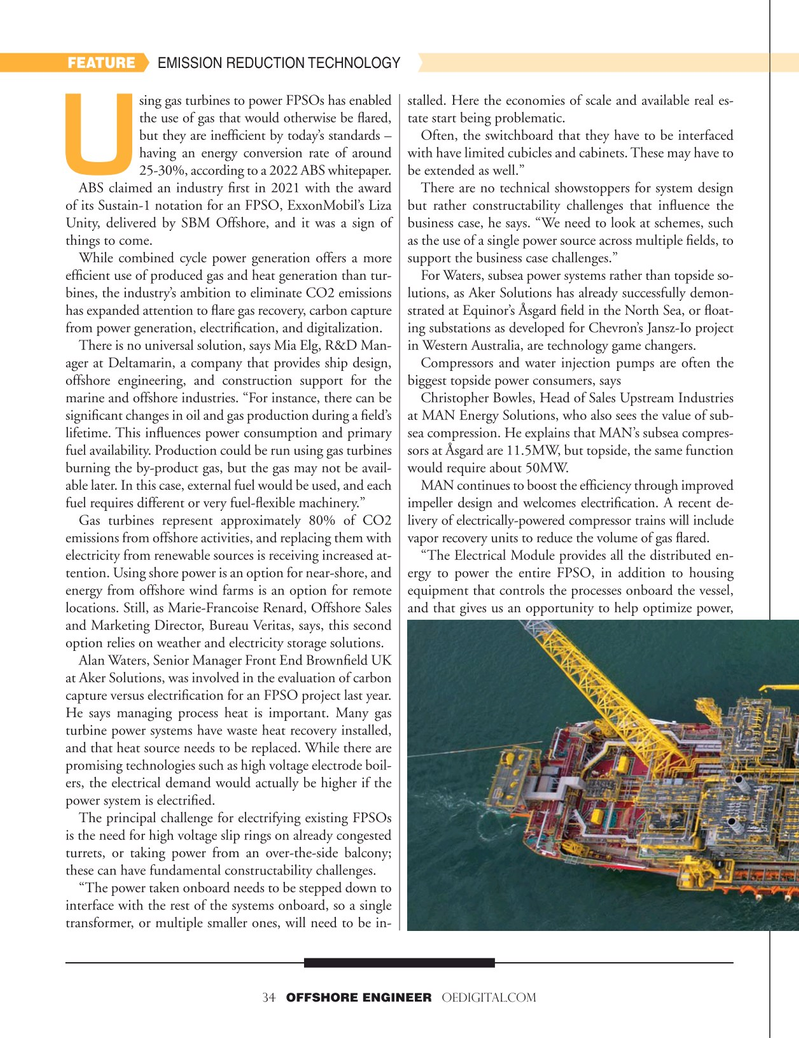
Page 34: of Offshore Engineer Magazine (Jan/Feb 2023)
Read this page in Pdf, Flash or Html5 edition of Jan/Feb 2023 Offshore Engineer Magazine
FEATURE EMISSION REDUCTION TECHNOLOGY sing gas turbines to power FPSOs has enabled stalled. Here the economies of scale and available real es- the use of gas that would otherwise be ?ared, tate start being problematic. but they are inef?cient by today’s standards – Often, the switchboard that they have to be interfaced having an energy conversion rate of around with have limited cubicles and cabinets. These may have to
U 25-30%, according to a 2022 ABS whitepaper. be extended as well.”
ABS claimed an industry ?rst in 2021 with the award There are no technical showstoppers for system design of its Sustain-1 notation for an FPSO, ExxonMobil’s Liza but rather constructability challenges that in?uence the
Unity, delivered by SBM Offshore, and it was a sign of business case, he says. “We need to look at schemes, such things to come. as the use of a single power source across multiple ?elds, to
While combined cycle power generation offers a more support the business case challenges.” ef?cient use of produced gas and heat generation than tur- For Waters, subsea power systems rather than topside so- bines, the industry’s ambition to eliminate CO2 emissions lutions, as Aker Solutions has already successfully demon- has expanded attention to ?are gas recovery, carbon capture strated at Equinor’s Åsgard ?eld in the North Sea, or ?oat- from power generation, electri?cation, and digitalization. ing substations as developed for Chevron’s Jansz-Io project
There is no universal solution, says Mia Elg, R&D Man- in Western Australia, are technology game changers. ager at Deltamarin, a company that provides ship design, Compressors and water injection pumps are often the offshore engineering, and construction support for the biggest topside power consumers, says marine and offshore industries. “For instance, there can be Christopher Bowles, Head of Sales Upstream Industries signi?cant changes in oil and gas production during a ?eld’s at MAN Energy Solutions, who also sees the value of sub- lifetime. This in?uences power consumption and primary sea compression. He explains that MAN’s subsea compres- fuel availability. Production could be run using gas turbines sors at Åsgard are 11.5MW, but topside, the same function burning the by-product gas, but the gas may not be avail- would require about 50MW. able later. In this case, external fuel would be used, and each MAN continues to boost the ef?ciency through improved fuel requires different or very fuel-?exible machinery.” impeller design and welcomes electri?cation. A recent de-
Gas turbines represent approximately 80% of CO2 livery of electrically-powered compressor trains will include emissions from offshore activities, and replacing them with vapor recovery units to reduce the volume of gas ?ared.
electricity from renewable sources is receiving increased at- “The Electrical Module provides all the distributed en- tention. Using shore power is an option for near-shore, and ergy to power the entire FPSO, in addition to housing energy from offshore wind farms is an option for remote equipment that controls the processes onboard the vessel, locations. Still, as Marie-Francoise Renard, Offshore Sales and that gives us an opportunity to help optimize power, and Marketing Director, Bureau Veritas, says, this second option relies on weather and electricity storage solutions.
Alan Waters, Senior Manager Front End Brown?eld UK at Aker Solutions, was involved in the evaluation of carbon capture versus electri?cation for an FPSO project last year.
He says managing process heat is important. Many gas turbine power systems have waste heat recovery installed, and that heat source needs to be replaced. While there are promising technologies such as high voltage electrode boil- ers, the electrical demand would actually be higher if the power system is electri?ed.
The principal challenge for electrifying existing FPSOs is the need for high voltage slip rings on already congested turrets, or taking power from an over-the-side balcony; these can have fundamental constructability challenges.
“The power taken onboard needs to be stepped down to interface with the rest of the systems onboard, so a single transformer, or multiple smaller ones, will need to be in- 34 OFFSHORE ENGINEER OEDIGITAL.COM

 33
33

 35
35